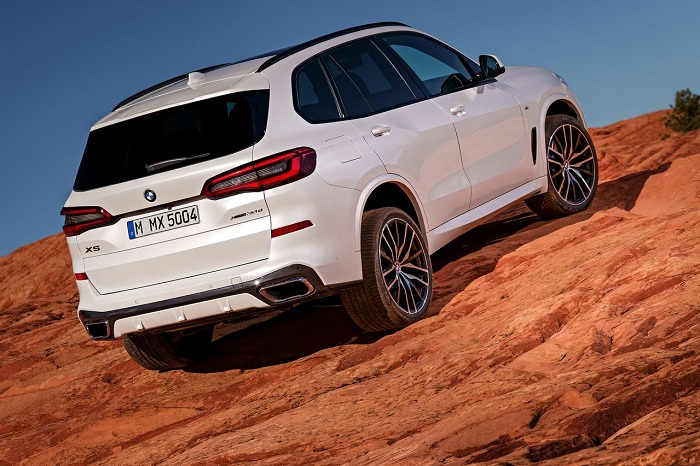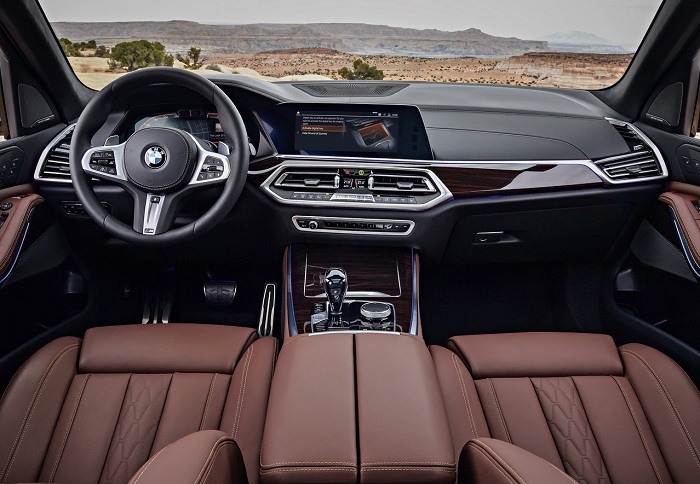Known internally as the G05 with production again set to take place at BMW’s Spartanburg, South Carolina Plant from November, the X5 not only a adopts an appearance similar to that of the X1 and X3, but also grows in every dimension with an overall length of 4 922mm (+36mm), wheelbase of 2 975mm (+42mm), width of 2 004mm (+66mm) and height of 1 745mm (+19mm).
While expected to be replaced by the X7 later this year as the brand’s new flagship offering, the X5’s respective gains has translated to an improvement in interior space, with 645-litres of boot space available as standard, or up to 1 860-litres with the rear seats folded down. Available from December though are two additional seats which can be electronically folded away or tilted.
Riding on a development of BMW’s CLAR platform used by the 5-and 7-series, as well as the X2, X3 and soon the new 3-series and X7, the X5 not only becomes the first BMW model to ride on (optional) 22-inch alloy wheels, but comes fitted as standard with Dynamic Damper Control, Adaptive M Suspension Professional with active roll stabilisation, a X model first Integral Active Steering system that turns the rear wheels to aid cornering in tight spaces and a new air suspension that raises ground clearance to 214mm.

In spite of BMW not releasing any details on the X5’s rumoured weight loss, the newcomer does usher in a new Off-Road Package, another X5 first, which raises the ride further, in addition to including an electronically controlled rear differential lock. No measurements with the aforementioned package in place have however been revealed.
As with the X2, the X5 will be offered in two trim levels; xLine and M-Sport, each with its own assortment of exterior detailing and wheel sizes ranging from 18-22 inches, while Sunstone Metallic can be selected from the BMW Individual paint catalogue for the first time.
Inside, the interior features a more minimalist layout with cues taken from the 5-series, highlighted by the dual 12.3-inch instrument cluster and iDrive infotainment system, the latter boasting the marque’s new 7.0 operating system, and incorporating Gesture Control, Bluetooth, Apple CarPlay, Connected Drive with Concierge Service, Wi-Fi and dual USB ports.
Another segment first, the X5 also boasts BMW Digital Key which allows buyers to unlock the doors using their smartphones, via the BMW Connected App. In addition, a colour Heads-Up Display, wireless smartphone charger, new ambient lighting, heated and cooled cupholders, panoramic sunroof and quad-zone climate control rounds off the interior, with a 20-speaker Bowers & Wilkins Diamond Surround Sound System, Rear-seat entertainment Professional system with dual 10.2-inch HD screens and a compatible Blu-Ray DVD player with two further USB ports and HDMI jack confirmed for availability from December.

As expected, driver assistance tech has been sharpened up with notable items being Collision Warning and Pedestrian Warning with City Braking, Emergency Stop Assistant, optional Active Cruise Control, Lane Change Assist, Traffic Jam Assist, Parking Assistant, a 3D 360 degree camera system, Rear Cross Traffic Alert, Lane Change Warning, Lane Departure Warning with active steering and Wrong-way warning.
In Europe, the X5 will initially go on sale with a choice of two petrol and two diesel engines, all sending their respective grunts through an eight-speed Steptronic gearbox to all four wheels via the familiar xDrive all-wheel drive system.
On the petrol front, the xDrive40i starts the range off with its 3.0-litre turbocharged straight-six mill producing 250kW/450Nm, allowing it to reach 100km/h from zero in 5.5 seconds and on to a limited top speed of 243km/h.
Until the arrival of the X5 M, which will reportedly pack the same 441kW motor as the M5, the xDrive50i will serve as the most powerful X5 available, with its 4.4-litre twin-turbo V8 mill churning out 350kW/650Nm. Top speed is limited to 250km/h with the benchmark 0-100km/h sprint taking 4.7 seconds.
Displacing three-litres, the xDrive30d serves as the entry-level diesel model with rated outputs of 195kW/620Nm, translating to a top speed of 230km/h and 0-100km/h in 6.5 seconds. At the sharp end, the M50d utilises the same engine, but adds a further three turbochargers to develop a whopping 294kW/760Nm. While limited to 250km/h, BMW claims that it will complete the zero to 100km/h dash in 5.2 seconds.
BMW South Africa has meanwhile confirmed that the X5 will make its local debut in the fourth quarter, with pricing to be announced closer to the actual launch date.
















